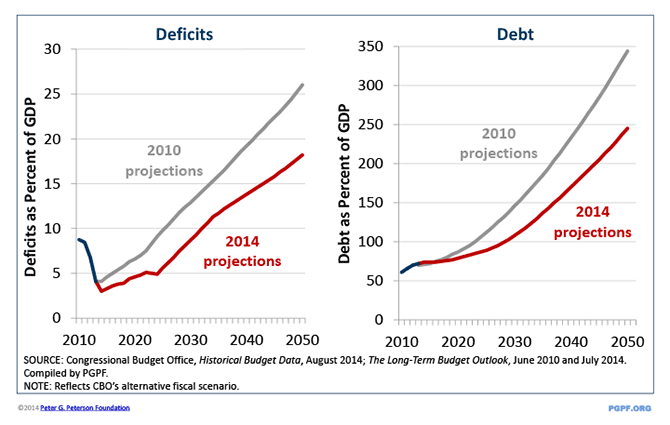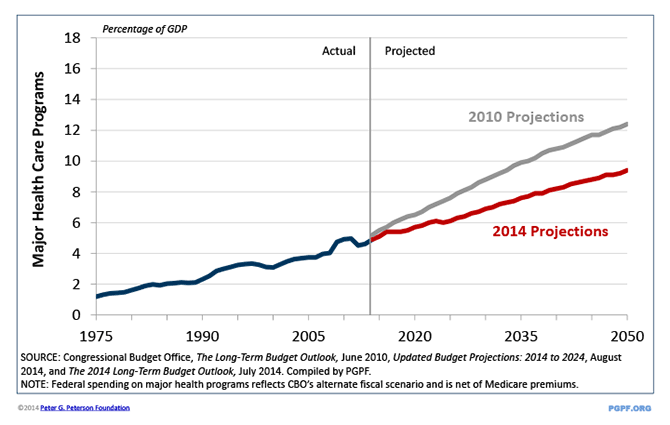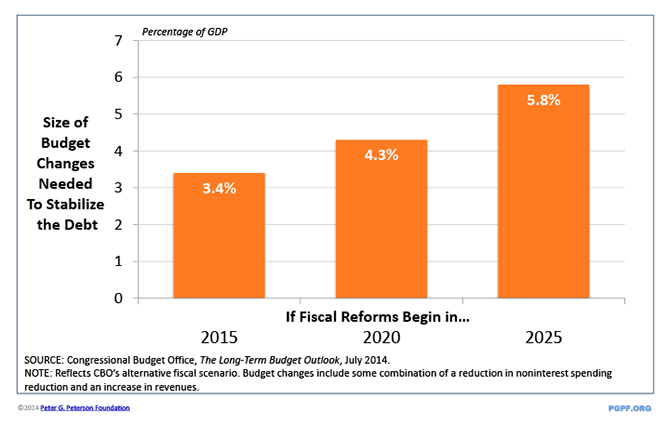You are here
Lame-Duck Deadlines and Long-Term Priorities
The mid-term elections may be over, but our nation’s fiscal and economic challenges remain. Despite recent reductions in the federal deficit, more action is needed to put the nation on a sustainable long-term fiscal path and support a still-recovering economy.
Lawmakers have an opportunity to take advantage of the upcoming legislative deadlines to make progress on the nation’s fiscal health. While it is likely that the 113th Congress will address only its most pressing deadlines before final adjournment, the incoming Congress should strive to be more forward looking. By considering the country’s long-term interests today, Congress can strengthen the economy and reduce the cost of reform for future generations.
Our Fiscal Challenges Are Far From Solved
While recent improvements to the federal deficit are welcome, we have not solved our long-term fiscal problems. Consider the following widely-held misconceptions:
Myth: Deficits have fallen and our budget is in good shape.
Reality: Yes, there has been a welcome improvement in current deficits as compared to those during the recession, but it’s clear that the recent trend of declining deficits won’t last long. According to CBO’s projections, deficits will begin rising again in 2018. Large deficits result in the growth of national debt and, over the long term, hurt the economy by lowering investment levels, reducing national income, raising interest rates, and reducing wages.
Recent budget improvements only delay the rise of the nation’s long-term deficits and debt

Myth: Growth in healthcare costs is no longer a problem.
Reality: While the CBO has adjusted its projections on healthcare costs downward since 2010, the long-term trend remains troubling. Federal healthcare costs are still projected to climb by over 90 percent — from 5 percent of GDP in 2014 to over 9 percent of GDP in 2050. This cost growth results from the aging of the population, the rising cost of care, and the expansion of subsidized health insurance through Medicaid and the insurance exchanges.
Projections of federal healthcare spending have improved but are still climbing as a share of the economy

Myth: The economy has recovered and we can grow our way out of fiscal challenges.
Reality: The welcome economic growth we’ve seen in recent years certainly helps to improve our fiscal position, but growth is not likely to be enough to solve these long-term fiscal challenges. Using CBO’s alternative fiscal scenario, we estimate that the U.S. economy would have to grow about twice as fast as our projected growth rate each year for the next twenty-five years in order to fully fix the fiscal imbalances. That outcome is highly unlikely — it would require a constant level of high annual growth rates never before recorded in American history.
Upcoming Deadlines
Lawmakers face a range of urgent fiscal tasks during the rest of the lame-duck session and over the coming months. These upcoming legislative deadlines present an opportunity for Congress to take action that would strengthen our economy and put the nation on a more sustainable fiscal path.
- December 11, 2014 — Appropriations for FY 2015: Congress must pass legislation to fund discretionary programs and avoid another government shutdown. Funding the government for the remainder of the fiscal year would put an end to the uncertainty that disrupts the efficient operation of programs and services. It would also allow the incoming Congress to focus on setting priorities for the future within current budgetary constraints.
- December 31, 2014 — Expiring Tax Provisions: Lawmakers face decisions before tax season begins in January about whether to renew the 55 tax provisions that expired at the end of 2013, and the 6 scheduled to expire at the end of 2014.1 A short-term extension seems likely to pass, but more fundamental reform is required to make the tax system more efficient and better suited to the global economy.
- March 16, 2015 — Debt Ceiling: Legislative action will be needed to allow federal borrowing once the debt ceiling is reinstituted in approximately mid-March. The debt ceiling has been suspended since February 2014, when lawmakers passed a last-minute measure in order to avoid default.
- April 1, 2015 — Medicare’s Sustainable Growth Rate: Congress must act to fix Medicare’s sustainable growth rate (SGR), or else the program’s reimbursements to physicians will be cut by nearly 24%. Rather than "patch" the problem with another temporary "doc fix," as they have done 17 times since 2003, lawmakers should address the root causes of this flawed policy.
- April 15, 2015 — Budget Resolution for FY 2016: Congress should meet the statutory deadline for adopting a budget resolution for fiscal year 2016. Congress has failed to pass a budget resolution for the past five years.
- May 31, 2015 — Highway Trust Fund: Congressional action will be necessary to address the exhaustion of the Highway Trust Fund in order to maintain highway and mass transit funding.
Conclusion
There is nothing to gain from a recurrence of the fiscal brinksmanship of recent years, which damaged the economy. In a study funded by the Foundation last year, Macroeconomic Advisers estimated that fiscal uncertainty from 2009 to 2013 raised unemployment by 0.6 percentage points — the equivalent of 900,000 lost jobs. Moreover, the longer we delay fiscal reforms, the more drastic the changes will have to be. Under CBO’s alternative fiscal scenario, we estimate taking action in 2015 to begin to stabilize the debt would require changes to revenue or spending of 3.4 percent of GDP. If action is delayed until 2025, this number climbs to 5.8 percent of GDP — a 70 percent increase.
Delaying action to stabilize the debt will make solutions harder in the long run

The approaching fiscal deadlines and the congressional budget process provide an opportunity for lawmakers to work through their differences, set priorities and work together on a sensible plan to address our long-term fiscal challenges. Addressing fiscal issues in a timely and proactive manner will help our economy, and our nation as a whole. By enacting a bipartisan plan that puts our long-term budget on a sustainable path, lawmakers could reduce uncertainty about our fiscal future, provide a much-needed boost to business and consumer confidence, and help our economy grow, now and in the future.
1Expiring Tax Provisions [link]. (Back to citation)
